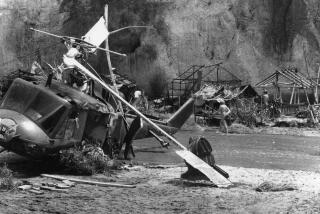Tape Disputed in Air Crash Trial
- Share via
The Cerritos midair collision case, which was mired in controversy for nearly two weeks before a mistrial was declared, was again plagued with legal wrangling Tuesday as the first witnesses began to testify in the second trial about the 1986 crash in which 82 people were killed.
The new hassle centered on two videotapes--accompanied by audio recordings--of the positions and the communications of the Aeromexico DC-9 and the small private plane in the minutes before they collided over a suburban neighborhood on Aug. 31, 1986.
While the new controversy did not delay proceedings as previous ones snagged the first trial, opposing attorneys and the federal judge presiding over the Los Angeles trial agreed that the new arguments are illustrative of the intricate and complex nature of the proceeding.
U.S. District Judge David V. Kenyon said the continuing interruptions of testimony for legal objections and other arguments are likely to hurt the jury’s morale in trying to determine who is responsible for the midair collision.
“This could get really messy,” the judge observed.
The first trial ended last week--before the first witness could even be called--when the judge agreed with attorneys for the Federal Aviation Administration that the jury had been “irrevocably tainted” by a suggestion in opening arguments that William Kramer, 53, the pilot of the Piper Archer, was somehow incapacitated when his aircraft hit the jetliner.
On its first day of testimony Tuesday, the second trial was proceeding smoothly when Steven J. Riegel, a Justice Department attorney representing the FAA, objected to the plaintiffs’ move to introduce the videotapes.
The videotapes, based on FAA computer data, would not show everything that air traffic controller Walter White saw on his screen at the time of the accident, Riegel said.
“It is also very prejudicial,” he added, contending that the jury would be given a distorted view of what happened.
The attorneys for the more than 70 plaintiffs suing the FAA and Aeromexico--contending that White had failed to warn the jetliner of the approaching small plane--argued that the tapes may be the best way to reconstruct what occurred.
“This is very close and accurate to what Walter White was dealing with” at the time of the crash, said the plaintiffs’ attorney, Joseph T. Cook.
Kenyon eventually allowed the introduction of one of the tapes, but the persistent legal sniping concerned him. The judge openly talked of setting aside whole afternoons--after the jury has been excused--to deal with the constant surge of objections over evidence.
The civil case is complex for several reasons. For one, the jury is charged with determining the amount of responsibility, if any, for the crash against Kramer’s estate. But it acts only in an advisory role in determining liability against the FAA or Aeromexico.
If the Kramer estate is dismissed as a defendant, the jury’s role in the trial is finished.
The trial is also complicated by a 1929 treaty, known as the Warsaw Convention, and its subsequent amendments, which limits international carriers’ liability to $75,000 per passenger--unless willful misconduct on the part of the carrier can be established.
Before the new round of legal hassles stopped the testimony and forced the jury’s early departure Tuesday, several witnesses told of what they saw of the crash.
An Orange County legal secretary who witnessed the collision said neither the Aeromexico jetliner nor the single-engine Piper Archer swerved before the accident.
“The planes went straight into each other,” said Cindy Gillespie, who saw the crash from the back yard of her mother’s home in La Palma, about a mile from the crash site. “Nobody seemed to try to swerve.”
More to Read
Sign up for Essential California
The most important California stories and recommendations in your inbox every morning.
You may occasionally receive promotional content from the Los Angeles Times.













